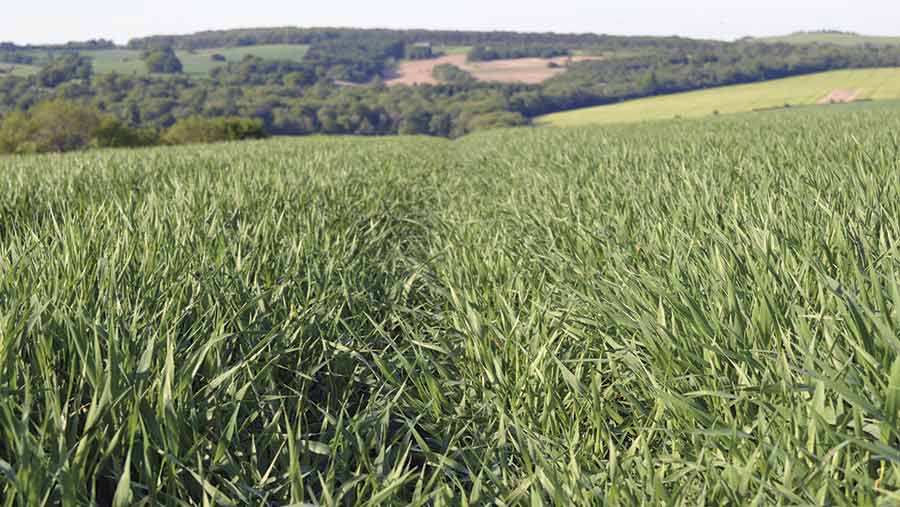Crop Watch: Rain eases crop stress but disease clings on
 FREE RE-USE (taken by David Jones/RBI)
FREE RE-USE (taken by David Jones/RBI) The recent rain has brought a halt to declining yield potential from drought, with growers swinging into action this week to protect cereals from disease pressure at the critical T2 stage.
Andy Goulding advises swift action to protect crops from mildew as the current weather conditions will allow it to flourish.
At this time of year, conclusions are also beginning to be drawn on variety performance, with Stephen Harrison spotting that Skyfall and Siskin have performed well in the dry conditions.
See also: Plant tissue tests lead to bumper wheat yields in Scotland
Micro nutrition is in the spotlight for Iain Richards, who urges growers to get an application of micronutrients on at T2 as copper, boron and manganese will preserve green leaf area.
Rain will allow weeds as well as crops to flourish, and Sean Sparling warns that some crops will have to be sprayed off before blackgrass is allowed to go to seed.
East: Sean Sparling

Sean Sparling
AICC/SAS Agronomy (Lincolnshire)
Winter wheat potential hasn’t been hurt too badly by the recent dry conditions and T2 is well under way with most varieties harbouring low levels of septoria in the canopy base and some varieties needing no encouragement to succumb to yellow rust once again.
Reflection and Lili are among the worst for yellow rust while Siskin and Evolution stand out as looking particularly good from all angles.
That said, leaf 1, 2 and 3 is generally very clean in most varieties, thanks to well-timed T1 applications and we aren’t in a curative situation currently.
Minimum 90% plus doses of either epoxiconazole or prothioconazole plus SDHI will still form the foundations of all T2 applications. In my opinion it would be a huge mistake to go backwards to triazole plus chlorothalonil alone to try and save a few quid.
Protection of those clean leaves is what it’s all about and with septoria inoculum rife in the base of most crops, this disease must take priority over all others.
Oilseed rape is largely out of flower now and due to the dry conditions only one fungicide has been required.
If you add that to the fact that pollen beetle and seed weevil have been insignificant pests to us this season not requiring insecticide applications, our impact upon bees and beneficials has once again been minimal.
Crop casualties inevitable on blackgrass land
Spring barley is receiving its T1 fungicide, growth stages vary from five leaves to first node, with stress symptoms and abiotic spotting widespread until the morning of the rain; by teatime the same day plants had grown away from it.
Some crops on blackgrass land are now coming full of blackgrass with the pre-ems getting fed up of waiting for rain.
As a result there will be casualties; we can’t allow it to return more seed to these fields so tough decisions are already being made.
Sugar beet weed control is generally good as the rains have thankfully reactivated the applied residuals.
However, as with all spring drillings this year, we are now faced with two crops in every field – the crop that emerged just after drilling seven weeks ago and the crop that’s emerging now thanks to the recent rain.
That complicates herbicide applications in beet and fungicide timings in spring cereals, but you should always go with the growth stage in the majority of the field.
South: Iain Richards
Agrii (Oxfordshire)

Iain Richards
The good inch of rain which fell across most of our downland in two days has been very welcome.
Equally welcome is the current unsettled, showery outlook in the run-up to winter wheat flowering, with temperatures forecast to remain reasonable. As we saw in 2011, skinny wheat crops with small flag leaves are still capable of rewarding us well if ear fertility is high and grain fill is good – especially when they’re as well-rooted as most of ours are.
However, relatively little leaf area to play with means keeping them green and clean is more important than ever.
Thank heavens we stuck with our planned early season spray and nitrogen programmes rather than over-reacting to the dry spring. With the heightened septoria risk following the rain, we’ll definitely be sticking to our T2 plans too – mainly based around fluxapyroxad with strong mixed triazole support.
My research colleagues have found this to be every bit as effective against the disease as programmes including either of the new SDHIs. As brown rust is obvious in the base of susceptible varieties like Crusoe, though, we will be using solatenol here for its clear activity advantages. Not least because we know how damaging the disease can be in warm, dry seasons.
Get micronutrition applied with T2 sprays
Micro-nutrition is also a priority for us at T2 to continue giving stressed crops the support they need – particularly boron, copper and magnesium.
Both copper and boron play a key role in ear fertility, magnesium is especially important in grain fill, and Agriifocus research shows all three are valuable in maintaining green leaf area. Our winter rape crops have also profited from the recent rain. Most have a lot of side-branching and excellent pod set. A prolonged flowering may have limited their yield potential by interfering with all-important May light interception.
There may also be a question over their ability to extract enough soil moisture to enable all the pods to fully fill.
Remember that every extra day of growing time is worth 1-2% on the yield, so the one thing we’ll be avoiding, wherever we can, is unnecessarily early desiccation, by looking to pod shatter resistant varieties and pod sealants for all the help they can give us.
West: Stephen Harrison
AICC/Southwest Agronomy (Avon)

Stephen Harrison
May is over half way through and at last the intensity of work with our crops is starting to relent.
Winter barley is now all done bar harvesting and winter oilseed rape awaits desiccation (let’s hope it’s not the last time we can use glyphosate) where necessary and harvesting.
Crops look in good order but the rush to ear emergence on stressed wheat crops and rather small flag leaves does not bode well for a record harvest.
There have been some interesting contrasts in the way varieties have tolerated the dry conditions.
Skyfall and Siskin have fared very well whereas Leeds and Revelation have struggled rather more. Graham has done well on better sites but looks very stressed on lighter grounds. I think there may be a new disease – stresstoria.
Irrespective of variety those crops on well-structured, adequate organic matter soils have suffered the least.
More mildew this season
Mildew has been more prevalent than usual. Cyflufenamid has performed well as a mildewcide. In mildew prone varieties we have majored on prothioconazole-containing products for the flag leaf spray, which should have all been applied as you read this.
There is a plethora of T2 materials available, therefore much time has been spent researching active ingredient levels, checking dose response curves and independent trials data.
T3 is looming quickly and plans are being made for prothioconazole or tebuconazole/prochloraz treatments on the milling wheats and tebuconazole plus azoxystrobin on the feed wheats.
Spring barley is nearing GS30 on better soils. Mildew is common in the thicker Propino crops. Poorly established crops in knobbly seed-beds are all over the place with some seeds only just germinated.
This is posing difficult questions over weed control. In some fields, we have fat hen with six leaves emerged while spring barley is just emerging.
Winter oilseed rape was flowering in the dry conditions of April and early May. Pod set looks excellent and sunshine and the odd rain shower from now on should set the scene for profitable crops.
North: Andy Goulding
CAS/Hutchinsons (Cheshire)

Andy Goulding
With the rain giving crops the kiss of life and T2’s behind us, attention is focused on spring cereals, which have gone from feeling sorry for themselves to accelerating away under the warm temperatures.
Some have even tried to prematurely end their life cycle under the drought stress so yield loss will have to be factored into these scenarios.
Most crops are in the midst of receiving their T1’s based around prothioconazole and chlorothalonil. Tissue analysis is showing good levels of macro nutrition on the whole in both winter and spring cereals with the exception of manganese.
With weather being conducive to mildew it is important this is addressed with timeliness as the two go hand in hand in defoliating the crop.
Actives in the main are proquinazid for lasting protection or fenpropimorph when quick action is needed, both partnered with a good dose of quality manganese.
Battle on blight begins
Emergence for many potato crops coincided with the first full Hutton period for all but one of my postcodes.
Although the forecast is currently low, the blight prevention programmes have kicked off before blight beats us to the field.
First blight sprays are centred on fluazinam to make a start at sealing the ridge for tuber blight with dimethomorph added in to provide some translaminar and anti-sporulant activity.
With the gavel passed back and forth on deciding maize pre-emergence herbicides the waiting game for efficacy is almost up.
One can assume those based on pendimethalin will have had the persistency until the rainfall to offer the breathing room sought by such practice.
Follow ups are now in discussion, with mesotrione being the minimum requirement before weed competition bears significance.
Zinc ammonium acetate is also good practice at this timing not only as a bio-stimulant to promote rooting and vigour but also as a crop safener and to supply crop requirements when high P index soils act as an antagonist to uptake.

